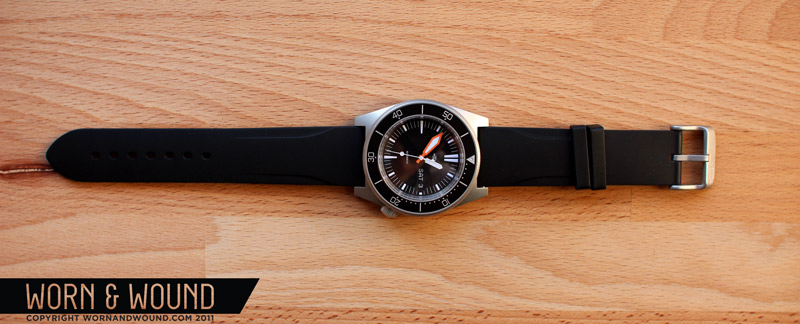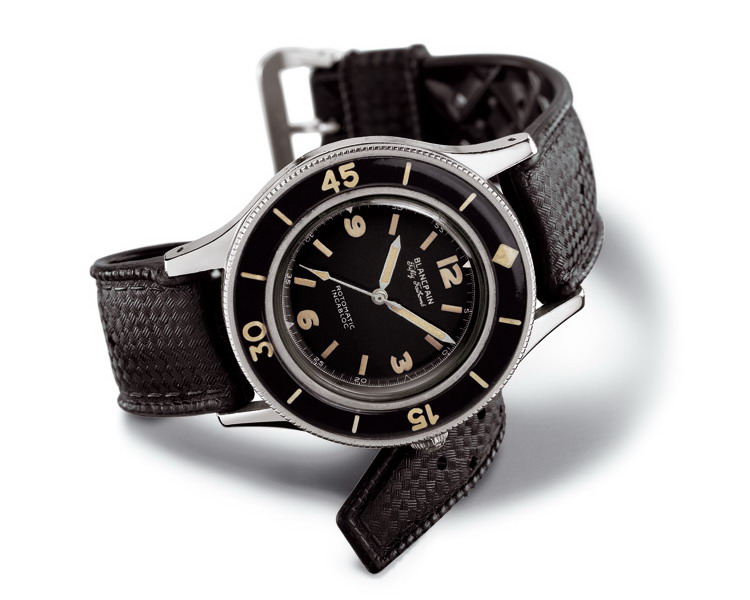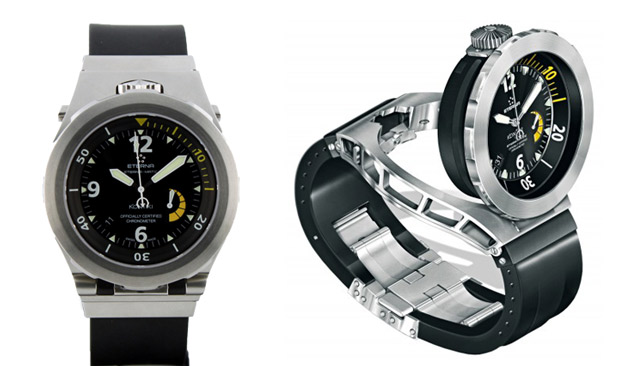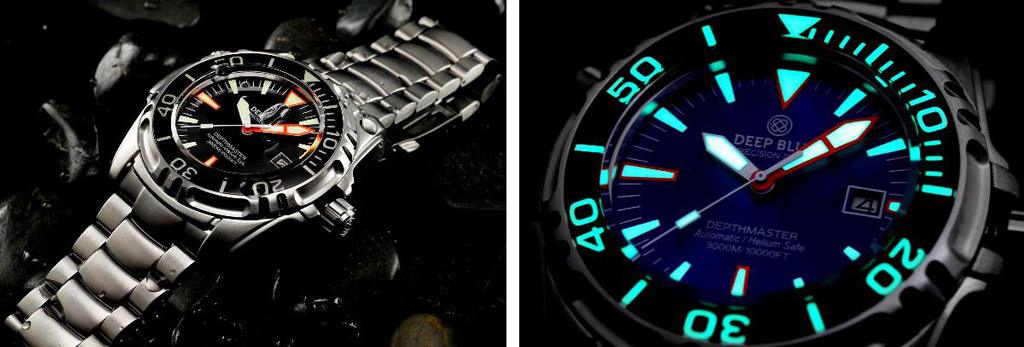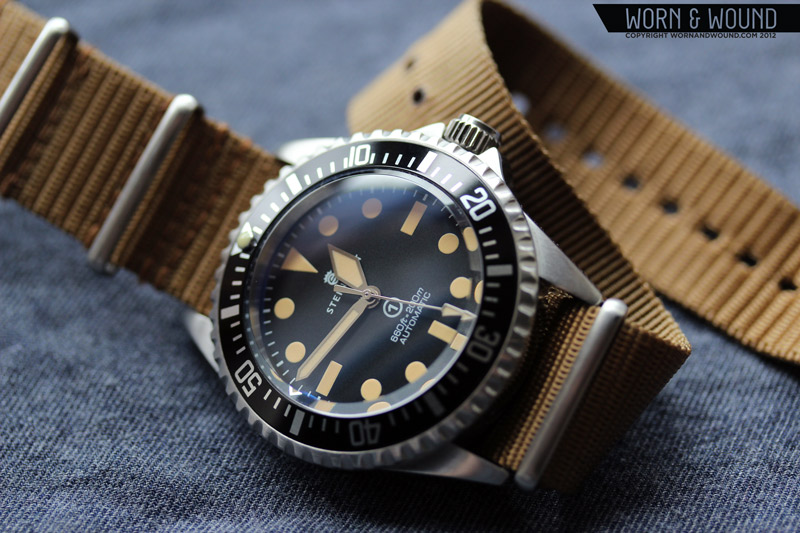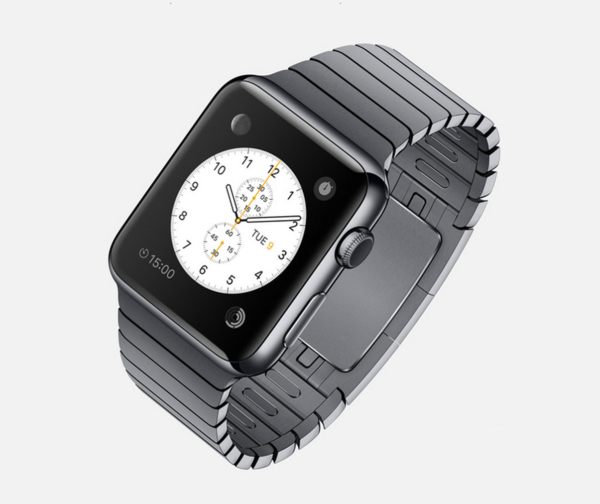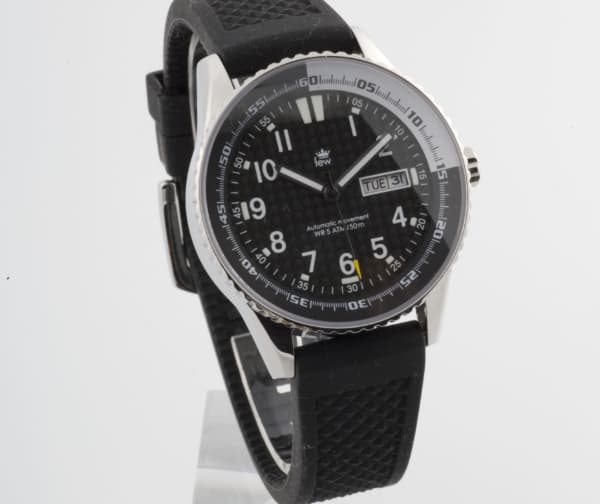Over half the watches I own are dive watches. On my next birthday I’ll hit that magical mark of 40 years and, as yet, I’ve never been deeper than the bottom of an eight-foot swimming pool – and even then my ears hurt like hell. So, why on earth (75% of which is covered with water!) do I need these small marvels of oceanographic engineering decorating my watch drawer?
My soul is full of longing for the secrets of the sea, and the heart of the great ocean sends a thrilling pulse through me. – Henry Wadsworth Longfellow
Well, there’s certainly a cool factor (see Bond, James) and there’s an aesthetic with dive watches that allows them to look at home with blue jeans or a blue suit. In fact, dive watches might be the perfect marriage of form and function – at once striking and useful. In short, the things that make dive watches vital equipment below the water typically make them the perfect companion when you’re on deck.
 Proof of that fact is just how many dive watches are on the market. Every major and minor producer has at least one, if not many, varieties of diving watches.
Proof of that fact is just how many dive watches are on the market. Every major and minor producer has at least one, if not many, varieties of diving watches.
Similar to a man’s need to climb tall mountains is his need to see beneath the glossy surface of our oceans. Whether it’s a snorkeling trip on a honeymoon or a major underwater excavation, the dive watch is a necessary piece of equipment for the explorer.
In fact, to be considered a diver, a watch must meet very specific criteria. It’s not enough for your watch to look like it can handle the deep, it must have the requisite features to both withstand the depths and provide timely information to the wearer.
Though many models choose not to become officially certified – it is a voluntary process with high costs attached – there is an international standard accompanying dive watches that sets forth precisely what is needed for a watch to be considered an instrument of the professional diver.
ISO 6425 established in 1996 provides a list of requirements that encompasses everything a watch needs to merit the title diver’s watch.
First, the watch must have a unidirectional bezel with at least every five minute elapsed minute markers and a pre-selected marker to mark minutes. Unidirectional is an important thing to note, for if the bezel turned both ways it’d be easy for a diver to knock it out of alignment and perhaps make it seem as if more time were present.
Next, the watch must have clearly distinguishable minute markers on the watch face. Obviously, this is a prominent feature of any watch and lends itself to the versatility of the dive watch – its uncluttered, easily readable dial makes it a pleasure to wear under many circumstances. A quick glance can often provide the time with little squinting or ciphering.
 You’ll find people compare two things most frequently on their dive watches – the lume and the depth rating. It’s a veritable mine-is-bigger-than-yours argument and people hunker down behind their favorite brands, defending their honor in each category.
You’ll find people compare two things most frequently on their dive watches – the lume and the depth rating. It’s a veritable mine-is-bigger-than-yours argument and people hunker down behind their favorite brands, defending their honor in each category.
On these two features, ISO requires a minimum depth of 100 meters (though most models start at the 300m mark) and an ability to be read in total darkness up to 9.8 inches. Helping you to read the time is the required luminosity and, in particular, ISO requires the presence of an indicator to know the watch is running in total darkness. Usually, this means the lumed second hand, or at least a sweeping second hand with a lumed tip.
Up next is the need to be magnetic, shock, and chemical resistant. The latter qualification is why we see so much stainless steel, titanium, and rubber in the dive watch community.
ISO also demands solidity of the band or strap, and pressures tests the spring bars to ensure the watch can stay on the wrist in adverse conditions.
And, finally, if you’re sporting a quartz diver, the presence of an End-of-Life indicator is a must to meet ISO 6425 standards.
Again, meeting the requirements set forth by ISO 6425 is something a great many watches do, even if they’re not officially certified. Companies pour so much money into research and development, marketing and the like, that it stands to reason they may not wish to throw more coin around on what amounts to ceremony. Still, it’s nice to know there are requirements built to keep me safe under the water. Even if I’m just in that backyard pool!
THREE ICONS
In the historical timeline of dive watches, I believe three models stand out as iconic. That’s a debatable point and I won’t argue hard against the person who takes one or more of these out and replaces them with something else. But, in terms of aesthetic and significance, it’s tough to beat the enduring popularity of the Blancpain Fifty Fathoms, the Rolex Submariner, and the Omega Ploprof.
Do a search for dive watches and what you’ll find watches, at every price point, that likely share design similarities with one of these three. It may be the distinctive bezel of the Fifty Fathoms, the beautiful simplicity of the Sub as a whole, or perhaps the monobloc case and amazing size of the Ploprof. The fact that these three watches are so often copied is a testament to their place in the pantheon of dive watches.
However, in spite of their status as legends I’m not going to spare any more words describing them. Each has a decorated history associated with it and rightly so. They deserve the accolades heaped upon them. For many an enthusiast, one or all of the three is tops on the grail list.
Rather than revisit these watches and the powerful companies that make them, I’d like to highlight three other watches. I could write this piece a hundred times and likely find three different models each time – so don’t mistake this list as being comprised of the next-best three. There are simply too many watches in the category to possibly whittle it down.
HISTORY. DESIGN. AFFORDABILITY
What each of the following selections offers though is something different for the buyer – be it history, unique design, or affordability.
Rolex and Omega have amazing histories, as do many other Swiss brands, and it’s that lineage that allows us to happily fork over a huge chunk of salary at the register. History, it would seem, is important to us.
Seiko fits right in.
After the 1964 Olympics Japan rode a wave of national pride and many a wonderful product was produced. Included in that long list was what Seiko hoped were serious diving watches. However, mixed reviews from the field forced designers back to the drawing board.
In 1975 that work paid off in the form of the Seiko Professional 600m Divers watch (6159-022). More than just a capable performer, this watch featured a laundry list of innovations.
Its case was the biggest marvel – titanium and made in such a way to be impervious to helium. Gone were the need for a helium release valve popular on other Swiss models and a necessary feature for anyone doing saturation diving.
Also a signature of this watch was the rubber vented diving strap. The vents weren’t for looks, rather they allowed the watch to be strapped tight over the wet suit, which might compress once in the water, and remain flexible for the wearer.
These developments made in the 70s can still be seen in Seiko’s line of top-flight diver’s today – the Prospect Marine Master 300m auto and the 300m Pro Quartz, and the 1000m Pro Diver.
Spend any time in the watch community and you’ll learn just how strong a following Seiko has as a brand. Indeed, it offers terrific fit and finish throughout its whole line and remains a tremendous value for the performance the watches offer.
 In 1947 Norwegian explorer Thor Heyerdahl decided to cross the pacific from Peru to Polynesia. Why? Probably because he could. He chose the vessel for his voyage to be a raft of prehistoric design named after the sun god of the original inhabitants of Peru – KonTiki.
In 1947 Norwegian explorer Thor Heyerdahl decided to cross the pacific from Peru to Polynesia. Why? Probably because he could. He chose the vessel for his voyage to be a raft of prehistoric design named after the sun god of the original inhabitants of Peru – KonTiki.
Heyerdahl wore an Eterna on his trip.
Eterna is not a company void of history; there’s certainly a lot of it. But, the focus here is on one of the latest models of the KonTiki diver that attempts to flip conventional design and wisdom on its ear: ref. 1594.44.40.1154. Or, as I like to think of it, the flip top.
Remember that list of qualifications from ISO? This watch would never make it, though one could argue it intends to perform as well or better than a watch that was to-the-letter-certified.
What Eterna decided to do different was look at two functions that typically go together with watches and separate them – watch movement protection and wrist attachment. This KonTiki does not have a screw down crown and proudly boasts a bi-directional bezel. So, why would anyone dive with it?
Borrowing from the automotive industry, Eterna used an interesting crankshaft system to engage the crown, allowing everything to be protected from water without the need to screw the thing down. In addition, the watch uses two push buttons to release the case from the bridge (only a picture will make sense of this) – here the user can utilize the bi-directional bezel as he chooses, setting it accordingly, before “locking” it back into the bridge. Once locked, the bezel can no longer move, therefore its bi-directional-ness matters not.
Whether it seems like too much, you have to admire a company with such history to take that kind of a leap. The watch is certainly striking and I’m guessing it’d be the only watch within a person’s collection that flipped open. Oddly enough, and no disrespect to Omega, but it feels Bond-like in it’s gadgetry.
The third watch doesn’t boast fancy features or even history to speak of. In fact, Deep Blue is at times scolded for being mass-marketed. Whichever side of the fence you fall on, the New York-based company certainly does it’s best to produce a solid dive watch at a great price, hitting all the marks along the way.
Though the entire Deep Blue line seems built for diving, the Depthmaster 3000 in particular bears noticing. It’s a mammoth watch at 49mm without the crown and must be hefty given its depth rating of 3000m.
It definitely hits the high notes for divers with its deep depth rating, terrific lume, 42-hour power reserve on its Japanese movement, helium-release valve, domed sapphire crystal and a sapphire bezel insert to boot.
One thing selling a lot of watches allows a company to do is keep prices low. All those features on another watch of another brand might demand a much higher price, but right now on the Deep Blue website the Depthmaster 3000 is available for $800.
For some of the watches mentioned in this article, $800 would be the sales tax.
CHOICES, CHOICES
The great thing about dive watches for the general consumer is that there are so many. There is something for everyone and for every budget within the category. The watches mentioned here are high end, or at least mid-to-high end, but you don’t have to spend $5000 or even $500 to get a great watch that you’ll feel comfortable wearing on recreational dives – or at your desk.
Looking for something similar to a Rolex Submariner? Try Steinhart and their Ocean line for under $500. Can’t shell out over ten grand for a Fifty Fathoms, give the Helson Skindiver a look-see on the used market (out of production right now). For under $700, you can get an extremely sharp looking, well built watch.
 Perhaps you just want to give a diver a try – look no further than the Seiko SKX007. It’s got classic Submariner styling and can be had new for less than $200.
Perhaps you just want to give a diver a try – look no further than the Seiko SKX007. It’s got classic Submariner styling and can be had new for less than $200.
Versatility, utility, and a healthy dose of the sport aesthetic make dive watches a terrific choice as everyday-wear watches. And though, for most of us, they’ll simply look sharp against the walnut-hue of our desktop, it’s nice to know one’s prepared should a scuba diving contest break out.
by JJ McDowell
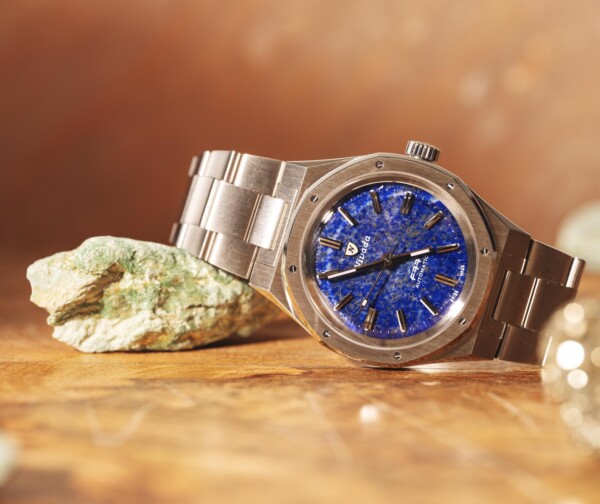








 Featured Videos
Featured Videos





